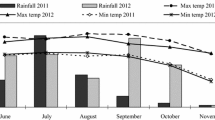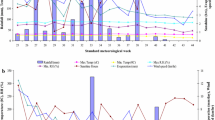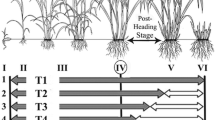Abstract
Intermittent and prolonged dry spell during growth of transplanted rice is an important abiotic problem in north eastern region (NER). However, the productivity of rice in the region is very low, and this is mainly associated with reduced plant population, growth, and yield attributes with lower relative water content and leaf rolling with formation of soil cracks by erratic and aberrant rainfall. Keeping this in view, a field experiment on transplanted rice was conducted during two consecutive years 2011 and 2012 at NER of India, to evaluate the imposition of forced surface drainage (SD) at various growth stages (continuous drainage, SD at tillering, SD at panicle initiation, SD at booting, SD at flowering, SD at milking, and 15 days intermittent SD) and was compared with continuous flooding on growth and yield attributes, yield, relative water content, leaf rolling, and formation of soil cracks. Results revealed that continuous flooding has significant (p < 0.05) improved the plant population, growth and yield parameters, rice grain yield (3,406.7 kg ha−1) and straw yield (4,683.3 kg ha−1), relative water content maintained >90 %, no leaf roll, and soil crack. However, imposition of SD at tillering has lower tillers hill−1, but yield was compensated by improvement in yield attributes. As per the availability of water, growers of the region can utilize the water for scheduling of water and most critical stages can be avoided by moisture stress to obtain higher productivity.





Similar content being viewed by others
References
Anjum F, Yaseen M, Rasul E, Wahid A, Anjum S (2003) Water stress in barley (Hordeum vulgare): effects on morphological characters. Pak J Agric Sci 40:43–44
Baruah KK, Rajkhowa SC, Das K (2006) Physiological analysis of growth, yield development and grain quality of some deep water rice cultivars. J Agron Crop Sci 192:228–232
Bonnet M, Camares O, Veisseire P (2000) Effect of zinc and influence of Acremonium lolii on growth parameters, chlorophyll a fluorescence and antioxidant enzyme activities of ryegrass (Lolium perenne L. cv Apollo). J Exp Bot 51:945–953
Bouman BAM, Tuong TP (2001) Field water management to save water and increase its productivity in irrigated lowland rice. Agric Water Manag 49:11–30
Bouman BAM, Peng S, Castaneda AR, Visperas RM (2005) Yield and water use of irrigated tropical aerobic rice systems. Agric Water Manag 74:87–105
Bouman BAM, Humphreys E, Tuong TP, Barker R (2006) Rice and water. Adv Agron 92:187–237
Cabangon RJ, Toung TP, Abdullah NB (2002) Comparing water input and water productivity of transplanted and direct-seeded rice production system. Agric Water Manag 57:11–31
Cabulsay GS, Ito O, Alejar AA (2002) Physiological evaluation of response of rice (Oryza sativa L.) to water deficit. Plant Sci 163:815–827
Canfield DE, Glazer AN, Falkowski PG (2010) The evolution and future of earths nitrogen cycle. Science 330:192–196
Cattivelli L, Rizza F, Badeck FW, Mazzucotelli E, Mastrangelo AN, Francia E, Marè C, Tondelli A, Stanca AM (2008) Drought tolerance improvement in crop plants: an integrated view from breeding to genomics. Field Crops Res 105:1–14
Cha-um S, Yooyongwech S, Supaibulwatana K (2012) Water-deficit tolerant classification in mutant lines of indica rice. Sci Agric 69(2):135–141
Choudhary VK, Kumar PS, Kanwat M, Bhagawati R (2012) Improvement of jhum with crop model and carbon sequestration techniques to mitigate climate change in Eastern Himalayan Region India. J Agric Sci 4(4):181–189
Choudhary VK, Kumar PS, Bhagawati R (2013) Response of tillage and in situ moisture conservation on alteration of soil and morpho-physiological differences in maize under Eastern Himalayan region of India. Soil Tillage Res 134:41–48
Choudhury BU, Das A, Kumar M, Ramesh T, Mohapatra KP, Verma BC, Ngachan SV (2013) Impact of elevated carbon dioxide and temperature on rice productivity in the mid altitude Meghalaya, Northeast India- results from a simulation study. J Agromet 15:1–3
Dingkuhna M, Audebert AY, Jones MP, Etienne K, Sow A (1999) Control of stomatal conductance and leaf rolling in O. sativa and O. glaberrima upland rice. Field Crops Res 61:223–236
Emmam Y, Shekoofa A, Salehi F, Jalali AH (2010) Water stress effects on two common bean cultivars with contrasting growth habitats. Am Eur J Agric Environ Sci 9(5):495–499
Godfray HCJ, Beddington JR, Crute IR, Haddad L, Lawrence D, Muir JF, Pretty J, Robinson S, Thomas SM, Toulmin C (2010) Food security: the challenge of feeding 9 billion people. Science 327:812–818
Gonzalez A, Martın I, Ayerbe L (2008) Yield and osmotic adjustment capacity of barley under terminal water-stress conditions. J Agron Crop Sci 194:81–91
Haines WB (1923) The volume changes associated with variations of water content in soil. J Agric Sci 13:269–310
Khush GS (2005) What it will take to feed 5.0 billion rice consumers in 2030. Plant Mol Biol 59:1–6
Kijne JW (2006) Abiotic stress and water scarcity: identifying and resolving conflicts from plant level to global level. Field Crops Res 97:3–18
Kumar R, Sarawgi AK, Ramos C, Amarante ST, Ismail AM, Wade LJ (2006) Partitioning of dry matter during drought stress in rainfed lowland rice. Field Crops Res 98:1–11
Li X, Waddington SR, Dixon J, Joshi AK, de-Vicente MC (2011) The relative importance of drought and other water-related constraints for major food crops in South Asian farming systems. Food Secur 3:19–33
Liu JX, Liao DQ, Oane R, Estenor L, Yang XE, Li ZC, Bennet J (2006) Genetic variation in the sensitivity of anther dehiscence to drought stress in rice. Field Crops Res 97:87–100
Munda GC, Das A, Patel DP (2009) Evaluation of transplanted and ratoon crop for double cropping of rice (Oryza sativa L.) under organic input management in mid altitude sub-tropical Meghalaya. Curr Sci 96(12):1920–1927
NEH (2005) Vision 2020. ICAR Research Complex for NEH region, Umiam
Novak V (1999) Soil crack characteristics- estimation methods applied to heavy soils in the NOPEX area. Agric Forest Meteorol 98–99:501–507
Pantuwan G, Fukai S, Cooper M, Rajatasereekul S, O’Toole JC (2002) Yield response of rice (Oryza sativa L.) genotypes to drought under rainfed lowlands. 2. Selection of drought resistant genotypes. Field Crops Res 73:169–180
Passioura J (2007) The drought environment: physical, biological and agricultural perspectives. J Exp Bot 58:113–117
Peng S, Bouman B, Visperas RM, Casteneda A, Nie L, Park HK (2006) Comparison between aerobic and flooded rice in the tropics: agronomic performance in an eight season experiment. Field Crops Res 96:252–259
Pirdashti H, Tahmasebi SZ, Nematza DG (2004) Study of water stress effects in different growth stages on yield and yield components of different rice cultivars. 4th International Crop Science Congress, Brisbane, Australia
Rahman MT, Islam MT, Islam MO (2002) Effect of water stress at different growth stages on yield and yield contributing characters of transplanted Aman rice. Pak J Biol Sci 52:169–172
Reddy AR, Chaitanya KV, Vivekanandan M (2004) Drought-induced responses of photosynthesis and antioxidant metabolism in higher plants. J Plant Physio 161:1189–1202
SAS (2010) SAS version 9.2. SAS Institute, Inc, Cary
Sayed OH (2003) Chlorophyll fluorescence as a tool in cereal crop research. Photosynthetica 41:321–330
Yeo ME, Cuartero J, Flowers TJ, Yeo AR (1997) Gas Exchange, water loss and biomass production in rice and wild Oryza species in well- watered and water limiting growth conditions. Int J Ger Bot Soc 110:32–41
Yoshida S (1981) Fundamentals of rice crop science the International Rice Research Institute. Los Banos, Laguna 269 pp
Zubaer MA, Chowdhury AKMMB, Islam MZ, Ahmed T, Hasan MA (2007) Effects of water stress on growth and yield attributes of aman rice genotypes. Int J Sustain Crop Prod 2(6):25–30
Author information
Authors and Affiliations
Corresponding author
Rights and permissions
About this article
Cite this article
Choudhary, V.K. Growth behavior, productivity, leaf rolling, and soil cracks on transplanted rice in response to enforce surface drainage. Paddy Water Environ 13, 507–519 (2015). https://doi.org/10.1007/s10333-014-0469-4
Received:
Accepted:
Published:
Issue Date:
DOI: https://doi.org/10.1007/s10333-014-0469-4




